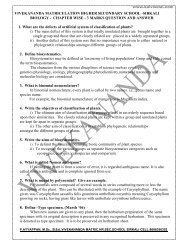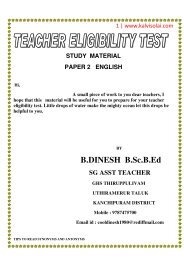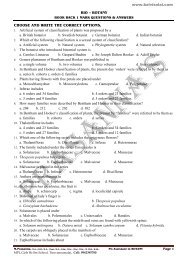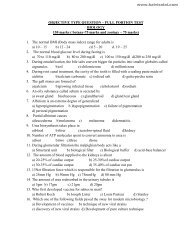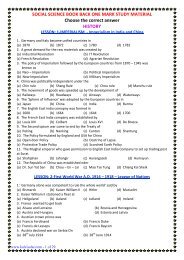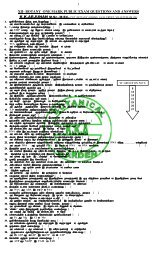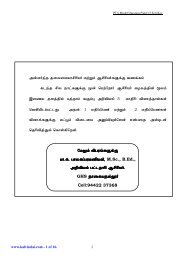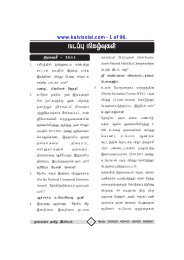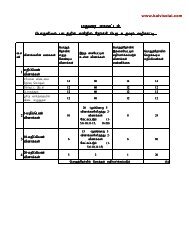TET - PAPER – II - kalvisolai
TET - PAPER – II - kalvisolai
TET - PAPER – II - kalvisolai
You also want an ePaper? Increase the reach of your titles
YUMPU automatically turns print PDFs into web optimized ePapers that Google loves.
<strong>TET</strong> - <strong>PAPER</strong> <strong>–</strong> <strong>II</strong><br />
muR muR khÂç khÂç jhS¡fhd jhS¡fhd<br />
jhS¡fhd<br />
édh édh éilfŸ<br />
éilfŸ<br />
fšé¢ nrhiy <strong>–</strong> jftš fsŠÁa¤Âš v‹Dila fU¤J¡fis <strong>TET</strong> vGJ«<br />
khzt, khzt, khzéfë‹<br />
khzéfë‹<br />
1<br />
vGJ«<br />
kdš gÂa it¡f thŒ¥òfŸ tH§»a<br />
“fšé¢ fšé¢ fšé¢ nrhiy nrhiy nrhiy jªj jªj jªj fU¤J fU¤J fU¤J tŸsš tŸsš” tŸsš tŸsš k¥ÉFça ÂU. ÂU. ÂU. ÂU. K.K. njtjh° njtjh° njtjh° njtjh°<br />
KJãiy KJãiy KJãiy KJãiy g£ljhç g£ljhç g£ljhç g£ljhç MÁça® MÁça® MÁça® MÁça® Iah mt®fS¡F e‹¿.<br />
www.<strong>kalvisolai</strong>.com<br />
ÂUk ÂUk kufj«, kufj«, M.A., M.Sc., M.Ed., M.Phil.,<br />
Rtd, Professor fšéæaš fšéæaš fšéæaš fšÿç,<br />
fšÿç,<br />
brš brš 8925770107
<strong>TET</strong> - <strong>PAPER</strong> <strong>–</strong> <strong>II</strong><br />
i. FHªij FHªij nk«ghL« nk«ghL« f‰Ã¤jš f‰Ã¤jš f‰Ã¤jš KiwfS«<br />
KiwfS«<br />
Child Development and Pedagogy<br />
1. j‹bd¿¥gL¤J« m¿Îiu¥ gf®jiy Ãugy¥gL¤Âat®<br />
A fh®šnuh#®° fh®šnuh#®° B lh®é‹ C ily® D gh›nyh<br />
Non Directive councelling was advocated by<br />
A Karl Rogers B Darwin C Taylor D Pavlov<br />
2. ‘fdÎfŸ MŒÎ’ v‹w üiy btëæ£lt®<br />
A #h‹ nlé B éšèa« n#«°<br />
C v£t®L Ô¢r‹° D Á¡k©£ Á¡k©£ Ãuh ÃuhŒL Ãuh<br />
The book titled ‘Dream Analysis’ was published by<br />
A John Dewey B William James C Edward Tichenes D Sigmund Freud<br />
3. kd¥nghuh£l§fë‹ tiffŸ<br />
A 4 B 2 C 3 D 8<br />
Types of Mental Conflicts are ___________<br />
A 4 B 2 C 3 D 8<br />
4. f‰Ã¤jè‹ Kjš goãiy<br />
A kÂ¥ÕL brŒjš B jah® brŒjš C thÁ¤jš D £läLjš<br />
£läLjš<br />
First step in Teaching<br />
A Evaluation B Preparation C pursuing D Planning<br />
5. jtwhd n#hoia F¿¥ÃLf<br />
a) E©z¿Î
During fertilization the chromosome received from the male partner is<br />
A Y B X C XY D XX<br />
7. E©z¿Î rh®ªj g‹Kf¡fhuâ¡ nfh£gh£oid msél jh©il¡<br />
TW« tê ahJ?<br />
A CVAD B CAVD C CDAV D CDVA<br />
Name the test deviced by Thorndike in multiple theory of Intelligence<br />
A CVAD B CAVD C CDAV D CDVA<br />
8. ö©lš-Jy§fš V‰gl¡ fhuz«<br />
A _is B K®¢Á C òy‹ òy‹ òy‹ cW¥òfŸ cW¥òfŸ cW¥òfŸ D mDgt§fŸ<br />
Stimulus <strong>–</strong> response is due to<br />
A Brain B Maturity C Sense organs D Experience<br />
9. A<br />
B<br />
nkny fhQ« ÏU nfhLfëš ‘A’ v‹w nfhL ‘B’ ia él Ús« FiwªJ<br />
fhQ« fh£Áæid _____________ vdyh«<br />
A<br />
B<br />
A ghOEf‹lh®¥ Âçò¡ fh£Á B gL¡if ne®nfhL Âçò¡ fh£Á<br />
C nršd®° Âçò¡ fh£Á D Kšy® Kšy®-ya® Kšy® ya® Âçò¡ fh£Á<br />
fh£Á<br />
In the above figure the line ‘A’ is perceived to be shorter than the<br />
line ‘B’. This is due to _____________<br />
A Poyendoffs illusion B Horizontal <strong>–</strong> Vertical line illusion<br />
C Zollener’s illusion D Muller-Lyer illusion<br />
10. Fku¥ gUt« xU Á¡fyhd mikÂa‰w gUt« vd¡ T¿at®<br />
A î¡r‹ B nfhš C °lh‹è Ahš D éšèa« éšèa« k¡^fš<br />
k¡^fš<br />
Adolescence is a period of storm and stress <strong>–</strong> said by<br />
A Brickson B Cole C Stanley Hall D William Mcdougall<br />
11. clš brašghLfŸ k‰W« cs¢ brašghLfŸ Ïu©oidÍ« Óuhf¢ brašgl cjΫ K¡»a<br />
ehsäšyh¢ Ru¥Ã ______________<br />
A ãô£lç Ru¥Ã B ijuhŒL Ru¥Ã C ghuhijuhŒL Ru¥Ã D m£ßdš m£ßdš Ru¥Ã Ru¥Ã<br />
Ru¥Ã<br />
The main ductless gland that regulates the physiological and<br />
psychological functioning of a person is ______________<br />
A The pituitary gland B Thyroid gland C Para thyroid gland D Adrenal gland<br />
www.<strong>kalvisolai</strong>.com<br />
3
12. e«Kila _jhija®fëläUªJ bjhl®ªJ tê têahf clš, cs¥g©òfŸ Ë rªjÂfS¡F<br />
É‹fë‹ _ykhf tUjiy ______________ vd miH¡»‹nwh«<br />
A gçzhk ts®¢Á B mL¤j rªj ãiy kh‰w«<br />
C cæçaš cæçaš kuò kuò ãiy ãiy D Ït‰¿š vJÎäšiy<br />
The transfer of physiological and genetic characters from parents to off springs through<br />
generations is called<br />
A Evolution B Transfer to next generation C Biological heridity<br />
D None of the above<br />
13. xU fU Ïu£ila®fŸ xnu NHèš ts®ªjnghJ, Ït®fëilna E©z¿Î
18. M¡fÂw‹ g‰¿a ä‹dnrhlh nrhjidæ‹ (bkhê k‰W« bkhêæšyh¢ nrhjid) cU¥gofŸ<br />
v¤jid<br />
A 10 B 14 C 12 D 19<br />
State the total number of creativity tests (Verbal + Non verbal) in Minnesota test of thinking<br />
A 10 B 14 C 12 D 19<br />
19. mfKf‹, òwKf‹ M»nahuJ Ïašòfis és¡»at®<br />
A nf£lš B Ir‹¡ Ir‹¡ C bf«¥ D ͧ<br />
Personality traits such as introvertism and extrovertism personality was explained by<br />
A Cattell B Eysenck C Kemp D Yung<br />
20. MSikia msél¥ ga‹gL« äf¥ bghU¤jkhd Kiw<br />
A Rarçij Rarçij B Ra kÂ¥ÕL C kWbkhê nfhUgit D kd¥gh‹ik msÎnfhš<br />
The most apt method of evaluating a person’s personality is through<br />
A Autobiography B Self rating C Questionnaire D Attitude scale<br />
21. äif ãiy kd« v‹w ãiy vªj taÂdU¡F V‰gL»wJ<br />
A 1-3 B 3-6 C 6-9 D 9-12<br />
Super ego stage occurs at the age of<br />
A 1-3 B 3-6 C 6-9 D 9-12<br />
22. ò%° l¡khå‹ MÁça® ju msÎ nfhèid¥ ga‹gL¤Â Ñœ¡F¿¥Ãl¥g£LŸs v¥g©Ãid<br />
MÁçaçl« msÅL brŒayh«<br />
A MÁçaç‹ el¤ij k‰W« M¡f¥g©ò B MÁçaç‹ gçÎ k‰W« V‰ò<br />
C MÁçaç‹ Ïa§F« g©ò k‰W« el¤ij D Ïit Ïit mid¤J«<br />
mid¤J«<br />
Which of the following can be evaluated using Bruce Tuckman’s Teacher Feedback form<br />
A Behaviour & Creativity B Warmth & acceptance<br />
C Dymanism & Organised demeanor D All the above<br />
23. Aš° v‹gtuJ f‰wš bfhŸifæid F¿¡F« N¤Âu« ahJ<br />
A SER = DRXSH x K <strong>–</strong> I B RES = DXSRH x K - I<br />
C SER = XDSRHR x K - I D S E R = DXS H R x K - I<br />
Hull’s theory of learning formulae is<br />
A SER = DRXSH x K <strong>–</strong> I B RES = DXSRH x K - I<br />
C SER = XDSRHR x K - I D S E R = DXS H R x K - I<br />
24. _isæš V‰gL« ãidé‰F äf K¡»a fhuzkhf Ïa§F« ntÂ¥bghUŸ<br />
A o.v‹.V. B M®.v‹.V. M®.v‹.V. C òuj« D fh®nghiAonu£<br />
The most potential chemical agent responsible for memory is<br />
A D.N.A. B R.N.A. C Proteins D Carbohydrates<br />
www.<strong>kalvisolai</strong>.com<br />
5
25. fhy taJ 8, kd taJ 7 k‰W« fhy taJ 7, kd taJ 8 cŸs Ï›éUtç‹ E©z¿Î
vd¥gL«. Xéa®fŸ v©z§fë‹ vG¢Áia gy t©z§fë‹ Jiz bfh©L<br />
vGJnthuhjè‹ f©QŸ éidP® vd¥g£ld®. M© Xéa® ‘Á¤juh§fj‹’ vdΫ, bg©<br />
Xéa® ‘Á¤Âunrdh’ vdΫ miH¡f¥gLt®.<br />
31. tisnfhLfŸ bfh©L tiua¥gLtJ<br />
A vGjh Xéa« B nfh£nlhéa«<br />
nfh£nlhéa« nfh£nlhéa« C òidah Xéa« D ghit Xéa«<br />
32. ‘f©QŸ éidP®’ v‹wiH¡f¥gLgt®<br />
A òyt® B ghlf® C eh£oa¡fhu® D Xéa®<br />
Xéa®<br />
33. `bg© Xéa®fŸ’ Ï›thW miH¡f¥gLt®<br />
A Á¤Âunrdh Á¤Âunrdh B Á¤Âuh§fj‹ C Á¤Âu¥ghit D Á¤Âu¡fhu¥ òè<br />
34. ‘ÚLJæš Ú¡f¥ gho tªj ãyh’ v‹W ah® ahiu¥ ghodh®<br />
A ghuÂjhr‹ ghuÂjhr‹ ghuÂia ghuÂia B ghu ghuÂjhrid C thâjhr‹ ghuÂia D ghu thâjhrid<br />
35. ËtUtdt‰¿š rçahd tçiria¤ nj®Î brOEf.<br />
A ngij, k§if, klªij, bgJ«ig B ngij, klªij, bgJ«ig, k§if<br />
C ngij, ngij, bgJ«ig, bgJ«ig, bgJ«ig, k§if, k§if, klªij klªij D ngij, k§if, bgJ«ig, klªij<br />
36. j‹ fšyiwæ‹ ÛJ, ‘j‹id xU jäoe khzt‹’ v‹W vGj¢ brh‹dt®<br />
A fhšLbtš B ÅukhKåt® C í.ô. í.ô. ngh¥ ngh¥ D Ínuå° ghuÂah®<br />
37. fy«gf¤Â‹ cW¥òfŸ<br />
A 10 B 14 C 8 D 18<br />
18<br />
38. `Fok¡fŸ fh¥Ãa«’ v‹W miH¡f¥gL« üš<br />
A Áy¥gÂfhu« Áy¥gÂfhu« B kânkfiy C ÓtfÁªjhkâ D tisahgÂ<br />
39. ‘Áwªj g¤ij’ j‹df¤nj bfh©l üš<br />
A K¤bjhŸshæu« B KJbkhê¡ KJbkhê¡ KJbkhê¡ fhŠÁ fhŠÁ C mil¡fy¥ g¤J D g‰W¥g¤J<br />
40. fhy§fuªj bgabu¢r«<br />
A éidK‰W B
44. ‘öu¤J xë’ v‹D« ÁWfijæ‹ MÁça®<br />
A ehŠÁš ehl‹ B th.nt.R. Ia®<br />
C fh.bfs. fh.bfs. fh.bfs. K¤jHf® K¤jHf® K¤jHf® D Á.R. bršy¥gh<br />
45. ‘ehŸnjhW« cl‰gæ‰Á brOE’ v‹gJ v›tif¤ bjhl®<br />
A f£lis¤ f£lis¤ f£lis¤ bjhl® bjhl® B brŒÂ¤ bjhl®<br />
C cz®¢Á¤ bjhl® D cl‹gh£L¤ bjhl®<br />
46. Kjš guâ üš<br />
A ghrtij¥ guâ B Ïuâatif¥ guâ<br />
C fè§f¤J¥guâ fè§f¤J¥guâ D j¡fahf¥guâ<br />
47. ‘Âiu¡fé¤ Âyf«’ v‹W eh« ahiu¡ F¿¥ÃL»nwh«<br />
A cLkiy ehuhaz fé B F.kh. ghyR¥Ãukâa«<br />
C m.kUjfhÁ m.kUjfhÁ D ghgehr« Át«<br />
48. K¢Óuhš tU« mo<br />
A Fwso B msto C Áªjo Áªjo D beoyo<br />
49. gÂbd© Ñœ¡fz¡F üšfëš cŸs òwüš<br />
A Ï‹dh eh‰gJ B fstê fstê eh‰gJ<br />
eh‰gJ<br />
50. ‘Nshkâ’ v‹D« üè‹ MÁça®<br />
C Ïåait eh‰gJ D fh® eh‰gJ<br />
A bga® bjçaéšiy B ehj¡F¤jdh® C njhyhbkhê¤ njhyhbkhê¤ njt® njt® D ÂU¤j¡f¤njt®<br />
51. bgçaòuhz¤Â‰F nr¡»Hh® Ï£l bga®<br />
A ÂU¤bjh©l® bjhif B nr¡»Hh® òuhz« C ÂU¤bjh©l® ÂUtªjhÂ<br />
D ÂU¤bjh©l® ÂU¤bjh©l® òuhz«<br />
òuhz«<br />
52. ‘kh®fê ó¤jJ’<br />
A bjhêyhF bga® B ÏlthF bga® C ÁidahF bga® D fhythF fhythF bga® bga®<br />
bga®<br />
53. v£L¤bjhif üšfëš mfK«, òwK« fyªj üš<br />
A beLªbjhif B g‰W¥g¤J C gçghlš gçghlš D FWªbjhif<br />
54. `mur‹’ v‹gij `miur‹’ v‹W TWtJ<br />
A Ïy¡fzKilaJ B k%c C Ïy¡fz¥ Ïy¡fz¥ nghè nghè D Ïl¡ful¡fš<br />
55. ‘bgh‹dfu«’ v‹w ÁWfijæ‹ MÁça®<br />
A b#afhªj‹ B òJik¥Ã¤j‹ òJik¥Ã¤j‹ C ÃugŠr‹ D F.gh. uh#nfhghy‹<br />
56. `jäoe ehlf¥ nguhÁça®’ v‹wiH¡f¥gLgt®<br />
A r§fujh° RthäfŸ B ngu¿P® m©zh<br />
C M®.v°. kndhf® D g«kš g«kš r«gªj r«gªj Kjèah®<br />
Kjèah®<br />
www.<strong>kalvisolai</strong>.com<br />
8
57. òfnHªÂ¥ òytiu Mjç¤j tŸsš<br />
A rªÂu‹ rªÂu‹ Rt®¡» Rt®¡» B rila¥g tŸsš C Ój¡fh D ghç<br />
58. ‘fW¥ò ky®fŸ’ v‹gJ<br />
A kuò¡ féij B iA¡T C òJ¡féij<br />
òJ¡féij òJ¡féij D èkiu¡T<br />
59. `fhto¢ ÁªJ’ ghoat®<br />
A m©zhkiyah® m©zhkiyah® B kfhfé ghuÂah® C murŠr©Kfdh® D mUz»çehj®<br />
60. t©z« fythkš fç¤J©Lfshš tot« tiutJ<br />
A t£oif¥ gyif B òidah òidah Xéa«<br />
Xéa« C t£oif¢ brOEÂ D eLfš tz¡f«<br />
iii. M§»y« M§»y« - English<br />
61. Choose the correct phrase to fill in the blank in the sentence.<br />
She ____________ living in Chennai since 1989.<br />
A have been B had been C have being D has been<br />
Fill in the blank with correct Homophone.<br />
62. I thought it might ______________<br />
A reign B rein C ruin D rain<br />
63. Change the given verb into noun form : Imagine<br />
A imagination B imagined C imaginative D imaginary<br />
In each of the following sentences, an idiomatic expression or a proverb is highlighted<br />
select the alternative which best describes its use in the sentence.<br />
64. The police will leave no stone unturned to discover the murderer<br />
A turn every stone B investigate thoroughly C make no excuse D be indifferent<br />
65. The concert was brought to a close with a display of fire works<br />
A concluded B interrupted C announced D cancelled<br />
In the following passage, there are blanks each of which has been numbered. Against each<br />
number, four words are suggested find out the appropriate word in each case<br />
A rich land owner was on his deathbed, gasping for breath. He told his three sons to dig<br />
under his bed when he was gone, and he died. Some days later, the sons dug at the spot and<br />
unearthed three pots, (66) one above the other. The first pot contained mud, the middle contained<br />
dried cow dung and the (67) pot contained straw. Below this pot there was a silver coin. The<br />
brothers were puzzled. “Obviously, father meant to (68) some message to us through the pots and<br />
their contents, said the eldest brother. They (69) for a while but (70) of them could come up with<br />
an explanation.<br />
Finally they decided to (71) their doctor, who was also a family friend. The doctor laughed<br />
when he, heard about their problem. ‘Your father loved puzzles,’ he said, ‘The interpretation is<br />
www.<strong>kalvisolai</strong>.com<br />
9
simple. The topmost pot contains mud you say, that (72) he wants his eldest son to have his fields.<br />
The second pot contains cow dung. It means he wants his second son to have his (73) of cattle.<br />
The last pot contains straw. Straw is golden coloured that means he wants his youngest so to<br />
have all his gold.’ The brothers were happy with the way their father had divided his wealth and<br />
appreciated the doctor’s (74).<br />
‘The silver coin at the bottom of the pots? What does it mean?’ asked the youngest brother.<br />
‘Your father knew you would come to consult me,’ smiled the doctor, ‘The coin is my (75).<br />
66. A only B stand C stood D placed<br />
67. A least B lowest C less D deep<br />
68. A tell B request C order D teach<br />
69. A think B thought C relaxed D taught<br />
70. A one B either C some D none<br />
71. A go B told C consult D take<br />
72. A meaning B telling C suggesting D means<br />
73. A herd B flock C gathering D school<br />
74. A effort B wisdom C brilliant D wit<br />
75. A friendship B pot C fee D keep<br />
Rearrange the following sentences in proper sequence to form a meaningful paragraph,<br />
and answer the given questions.<br />
A) The farmer called his neighbours and asked them to help him put mud into the well but the<br />
mule thought that he was calling the neighbours to help him get out of the well.<br />
B) A farmer wanted to get rid of his old mule and buy a new one but the mule always came back<br />
from wherever the farmer left him.<br />
C) He walked away from his cruel master and never returned.<br />
D) One day the mule fell into the well and the farmer thought, ‘Why not bury it there so that I don’t<br />
have to worry about getting rid of it?’<br />
E) The mule started shaking off all the mud that fell on him and kept climbing on the leap of mud<br />
as it fell into the well, soon he was on top of the mud heap and he easily got out of the well.<br />
F) When they started putting mud in the well the mule realized his master’s plan and started<br />
thinking of ways to say himself.<br />
Choose the correct order of the sentences from the list given below:<br />
76)<br />
A ABDCEF B BDAFEC C DFEABC D BDEFC<br />
In each sentence below one word has been underlined. Of the four words suggested under<br />
each sentence, one can replace the underlined word without changing the meaning of the<br />
sentence.<br />
www.<strong>kalvisolai</strong>.com<br />
10
Find out the appropriate word in each case.<br />
77. It was a useless attempt on her part to participate in the competition.<br />
A fruitful B future C last D futile<br />
78. He is reluctant to ask for permission o leave early.<br />
A unhappy B ungrateful C unwilling D unsatisfied<br />
Choose the word which is most opposite in meaning of the word given.<br />
79. Polite<br />
80. Reveal<br />
A angry B sheepish C offended D rude<br />
A show B exhibit C conceal D prohibit<br />
81. How many meaningful English words can be formed with the letters OTE using each letter<br />
once?<br />
A none B two C one D three<br />
The following sets of ideas / objects have some common feature / function. Spot the odd<br />
one out<br />
82)<br />
eg: bag, basket, hat, bucket<br />
Ans: hat <strong>–</strong> the others are used for carrying things.<br />
A bite B chew C suck D nibble<br />
83) Choose the appropriate word and fill in the blank<br />
I do not know what _____________ my father choose that particular school<br />
A happened B controlled C asked D made<br />
Read each sentence to find out whether there is any grammatical error in it. The error, if<br />
any, will be in one part of the sentence.<br />
The number of that part is the answer. It there is<br />
84) while he was walking along the road (A) / a speeding car (B) /<br />
knocked down to him (C) / no error (D)<br />
85) Everybody know that his failure can (A) / be attributed to (B) / his lack of practice (C) / No<br />
error (D)<br />
86) Do you wanted to discuss this (A) / project today or can (B) / we do it tomorrow (C) / no error<br />
(D)<br />
87) What animal is found, by taking the fifth letter of the second word, the ninth letter of the first<br />
word, the sixth letter of the fourth word and the fourth letter of the third word?<br />
PARTICIPATION<br />
SHOULDER<br />
SYMBOLICALLY<br />
www.<strong>kalvisolai</strong>.com<br />
11
SALESMAN<br />
A TOAD B LAMB C BULL D MARE<br />
88) A horse is tied to a 30 feet rope. A haystack lies 40 feet away, but the horse is able to eat it.<br />
How is this possible?<br />
A The horse is very smart. B The other end of the rope is not tied to anything.<br />
C The distance is not measured correctly.<br />
D The wind blew and brought the haystack close to the horse.<br />
89) In the Active Learning Method (ALM) Mind map is drawn to check the ________________ of<br />
the students.<br />
A drawing Skill B writing Skill C understanding of the content D to while away the time<br />
90) Identify the compound sentence :<br />
A He is too tired to walk<br />
B After he had done the sums he went to bed.<br />
C As she worked hard she completed the work.<br />
D The farmer was old and he could not plough the field himself<br />
iv. (b) Social Science<br />
<strong>TET</strong> khÂç khÂç édh¤jhŸ édh¤jhŸ / <strong>TET</strong> Model Question Paper<br />
r_f r_f m¿éaš m¿éaš Social Science<br />
jhŸ jhŸ <strong>–</strong> <strong>II</strong> - Paper <strong>–</strong> <strong>II</strong><br />
91. Au¥gh ehfßf¤Âš ‘bgU§Fs«’ ÏUªjJ v‹gJ cz®¤JtJ<br />
A Úç‹ K¡»a¤Jt« B Úç‹ Úç‹ òåj¤j‹ik<br />
òåj¤j‹ik<br />
C Úç‹ nrä¥ò D Úç‹ ga‹ghL<br />
The significance of the presence of ‘Great bath’ in Harappan Civilization<br />
A Importance of water B Holiness of water<br />
C Water Harvest D Utility of water<br />
92. cy»nyna äf¤ bjh‹ikahdbjd tuyh‰w¿P®fshš fUj¥gLtJ vJ?<br />
A f§if¢ rkbtë B éªÂa éªÂa kiy¡F¤ kiy¡F¤ kiy¡F¤ bj‰»YŸs bj‰»YŸs gF gFÂ<br />
gFÂ<br />
C tlnk‰F ϪÂa¢ rkbtë D ϪÂahé‹ tl»H¡F gFÂ<br />
Which is considered as the most ancient part of the world by historians?<br />
A Gangetic Valley B Southern part of Vindhya Mountain<br />
C North Western Indian Valley D North Eastern part of India<br />
www.<strong>kalvisolai</strong>.com<br />
12
93. ntj fhy bg© féP®fŸ<br />
A Ãu#hgÂ, éRtgÂ, rjkhdh B ãZfh, ghŠrhè, Rt®zh<br />
C fh®», ik¤nuæ, xsit D mgyh, mgyh, nfhrh, nfhrh, nyhgK¤uh nyhgK¤uh<br />
nyhgK¤uh<br />
The Female poets of Vedic period<br />
A Prajapathi, Viswapathi, Sadamana B Niska, Panjali, Swarna<br />
C Garki, Maithreyi, Avvai D Abala, Kosa, Lobamudra<br />
94. bgs¤j Jwéfë‹ éfhu§fŸ äFªj khãy«<br />
A f®ehlf« B Õfh® Õfh® Õfh® C #h®f©L D xorh<br />
The State that comprises more number of Buddhist Viharas is<br />
A Karnataka B Bihar C Jharkhand D Oddisa<br />
95. rªÂuF¥j bksçaç‹ M£Á¡ fhy«<br />
A ».K. 298-273 B ».K. ».K. 324 324-299 324 299 299 C ».K. 261-236 D ».K. 280-255<br />
The reign of Chandragupta Mauriya<br />
A B.C. 298-273 B B.C. 324-299 C B.C. 261-236 D B.C. 280-255<br />
96. Áuht°Â v‹gJ<br />
A e B ntjüš C efu« efu« D nfhéš<br />
‘Siravasthi’ means<br />
A River B Holy book C Town D Temple<br />
97. A®õ® tlbkhêæš vGÂa üš<br />
A fnuh°Â B j®k j®k é#a« é#a« C K¤uuh£rr« D u¤dhtë<br />
The book written by Harsha in Sanskrit<br />
A Karosthi B Dharma Vijayam C Mudraratshasam D Ratnavali<br />
98. Á-ô-» v‹D« üš TWtJ<br />
A A®õç‹ ã®thf« B bgs¤j bgs¤j kj«<br />
kj«<br />
C A®õç‹ gilbaL¥ò D ehsªjh gšfiy¡fHf«<br />
The book ‘Si-Yu-Ki’ is on<br />
A Administration of Harsha B Buddhism<br />
C Conquests of Harsha D Nalanda University<br />
99. f#]uhnAh nfhéiy¡ f£oat®fŸ<br />
A rªnjy®fŸ B Ïuh#ò¤Âu®fŸ<br />
Ïuh#ò¤Âu®fŸ<br />
C brsfh‹fŸ D ÃuÂfhu®fŸ<br />
‘Khajuraho’ temple was built by<br />
A Sandelas B Rajputs C Chauhans D Prathiharas<br />
www.<strong>kalvisolai</strong>.com<br />
13
100. bAhŒrhs k‹d® éZQt®jd®, jiyefiu nrhrÅ® v‹w Ïl¤ÂèUªJ kh‰¿a Ïl«<br />
A thu§fš B njt»ç C bt§» D JthurK¤Âu«<br />
JthurK¤Âu«<br />
Vishnuvardhana, the Hoysala king, who shifted his capital from Sosaveer to<br />
A Warangal B Devagiri C Venki D Dwara Samudra<br />
101. I«bgh‹dhš Áiy brOEÍ« fiyia m¿Kf¥gL¤Âat®fŸ<br />
A gšyt®fŸ B Éfhy¥ gšyt®fŸ C nrhH®fŸ D Éfhy¢ Éfhy¢ nrhH®fŸ<br />
nrhH®fŸ<br />
Iconography was introduced by<br />
A Pallavas B Later Pallavas C Cholas D Later Cholas<br />
102. KfkJ fíåæ‹ 17 gilbaL¥òfis¥ g‰¿¡ F¿¥ÃL« tuyh‰W MÁça®<br />
A r®. #h‹ kh®õš B r®. jhk° C r®. r®. bA‹¿ bA‹¿ vèa£ vèa£ D r®. bA‹¿ ngh®L<br />
The historian, who mentioned the 17 invasions of Muhamed Gazani was<br />
A Sir. John Marshal B Sir. Thomas C Sir. Henry Elliot D Sir. Henry Ford<br />
103. ‘yh¡g¡õh’ vd¥ òfH¥g£l mur®<br />
A F¤òÔ‹ F¤òÔ‹ Ig¡ Ig¡ B ghšg‹ C ÏšLäZ D eRUÔ‹<br />
The King who was praised as ‘LakBaksha’<br />
A Qut-pu-din Ibek B Balban C Iltumish D Nasurudeen<br />
104. blšè Ršjh‹fŸ M£Áæš btëÍwΤ Jiw mik¢rç‹ bga®<br />
A Âthå Ï‹õh B Âthå Âthå ç[hy¤ ç[hy¤ C Âthå m®° D Âthå M«<br />
The name of the Foreign Minister in the Rule of Delhi sultanate was<br />
A Diwani Inshah B Diwani Rizalat C Diwani Urs D Diwani Am<br />
105. jiy¡nfh£il¥ ngh® eilbg‰w M©L<br />
A ».Ã. 1545 B ».Ã. 1555 C ».Ã. ».Ã. 1565 1565 D ».Ã. 1575<br />
Battle of ‘Talaikottai’ was held in the year<br />
A AD 1545 B AD 1555 C AD 1565 D AD 1575<br />
106. _‹whtJ ghåg£ nghU¡F K‹ gŠrhig if¥g‰w ϪÂahé‹ ÛJ gyKiw gilbaL¤jt®<br />
A fíå Kf«kJ B Kf«kJ nfhç C mfkJ mfkJ õh õh m¥jhè m¥jhè D xsu§fÁ¥<br />
The King who invaded India many a times to capture Punjab before the third Battle of Panipet<br />
A Gazani Mohamud B Mohamud Ghori<br />
C Ahamed Shah Abdali D Auranzeb<br />
107. òuªj® cl‹go¡if nk‰bfhŸs¥g£l M©L<br />
A ».Ã. 1650 B ».Ã. ».Ã. 1665 1665 C ».Ã. 1660 D ».Ã. 1655<br />
Treaty of ‘Purandhar’ was signed in the year<br />
A AD 1650 B AD 1665 C AD 1660 D AD 1655<br />
www.<strong>kalvisolai</strong>.com<br />
14
108. M§»y¥ nguuir ϪÂahéš njh‰Wé¤jt®<br />
A Ïuhg®£ Ïuhg®£ »is› »is› B oô¥ns C ä®#hg® D r® Ia® T£<br />
The person who established British rule in India<br />
A Robert Clive B Duplex C Mirjafer D Sir. Iyercoot<br />
109. thu‹ nA°o§° M£Áæ‹bghGJ mnah¤ÂÍl‹ Ïiz¡f¥g£l gFÂ<br />
A #h®¡f©L B c¤Âufh©L C nuhïšf©L nuhïšf©L D gªjš fh©L<br />
The place annexed with Oudh during the rule of Warren Hastings<br />
A Jharkhand B Utharkhand C Rohilkhand D Bundlekhand<br />
110. ‘ikN® òè’ vd miH¡f¥g£lt®<br />
A iAj® mè B Â¥ò Â¥ò Ršjh‹ Ršjh‹ C r¥j® mè D gnj¡ iAj®<br />
The person who was named as ‘Tiger of Mysore’<br />
A Hyder Ali B Tippu Sultan C Sabdar Ali D Fadek Hyder<br />
111. ».Ã. 1453 M« M©o‹ K¡»a¤Jt«<br />
A mšòf®¡F Ïu©lhtJ MSeuhf gjéna‰wJ<br />
B bfhy«g° flš gaz¤ij nk‰bfh©lJ<br />
C JU¡»a®fŸ JU¡»a®fŸ fh‹°lh‹o fh‹°lh‹o nehÃis¡ nehÃis¡ if¥g‰¿aJ<br />
if¥g‰¿aJ<br />
D m«ghædh gLbfhiy elªjJ<br />
The importance of the year 1453 AD<br />
A Albuequrque who appointed as second Governor<br />
B The sea route journey of Columbus<br />
C Constantinoble was captured by Turks<br />
D The massacre of Ambaina<br />
112. kJiu eha¡f® M£Áæ‹ filÁ M£Áahs®<br />
A ÂUkiy eha¡f® B Ûdh£Á Ûdh£Á C Ïuhâ k§f«khŸ D é°tehj eha¡f®<br />
The last ruler of Madurai Nayakas was<br />
A Thirumalai Nayak B Meenakshi C Rani Mangammal D Viswanatha Nayak<br />
113. gšyt®fŸ fhy¤Â‹ M£Á bkhê<br />
A jäœ B »uªj« C ghè D rk°»Uj«<br />
rk°»Uj«<br />
The official language of Pallavas is<br />
A Tamil B Grantham C Pali D Sanskrit<br />
114. rKjha K‹nd‰w¤Â‹ éisãy«<br />
A ÅL B FL«g« C gŸë gŸë gŸë D r_f«<br />
The nurturing field of social progress<br />
A House B Family C School D Society<br />
www.<strong>kalvisolai</strong>.com<br />
15
115. ϪÂahéš cŸsh£Á mik¥ig Kj‹Kjèš V‰gL¤Âat®<br />
A f®r‹ Ãuò B fhå§ Ãuò C ç¥g‹ ç¥g‹ Ãuò Ãuò D lšbAsÁ Ãuò<br />
The local Government in India was initially established by<br />
A Lord Curzon B Lord Canning C Lord Rippon D Lord Dolhouse<br />
116. jäoeeh£oYŸs Cuh£Á x‹¿a§fë‹ v©â¡if<br />
A 370 B 375 C 380 D 385<br />
Total number of Panchayat Unions in Tamil Nadu<br />
A 370 B 375 C 380 D 385<br />
117. khãy§fsitæš FoauR¤ jiytuhš ãakd« brŒa¥gL« cW¥Ãd®fë‹ v©â¡if<br />
A 12 B 14 C 16 D 18<br />
The number of persons nominated by President in Rajya Saba<br />
A 12 B 14 C 16 D 18<br />
118. _‹W khãy§fëš mikªJŸs ôåa‹ Ãunjr«<br />
A ilô, lhk‹ B jh¤uh ehf® iAntè C r©of® D òJ¢nrç<br />
òJ¢nrç<br />
The Union Territory that is located in three State<br />
A Dieu, Damen B Dadra-Nagar Highvalley C Chandigar D Puducherry<br />
119. ϪÂahé‹ bkh¤j gu¥gsÎ<br />
A 32 32 87, 87, 263 263 r.».Û. r.».Û. B 31 87, 263 r.».Û. C 34 88, 326 r.».Û. D 32 86, 362 r.».Û.<br />
The total area of India<br />
A 32 87, 263 Sq.Km B 31 87, 263 Sq.Km C 34 88, 326 Sq.Km D 32 86, 362 Sq.Km<br />
120. muÁaš ã®za rigæ‹ Kjš T£l¤Â‰F jiyik t»¤jt®<br />
A lh¡l® Ã.M®. m«ng¤fh® B lh¡l®. lh¡l®. r¢Ájhdªj r¢Ájhdªj Á‹fh<br />
Á‹fh<br />
C lh¡l® nf.v«. K‹î D lh¡l® Ïuhn#ªÂu Ãurh¤<br />
The first meeting of constituent Assembly was presided by<br />
A Dr. B.R. Ambedkar B Dr. Sachidananda Sinha<br />
C Dr. K.M. Munshi D Dr. Rajendra Prasad<br />
121. midtU¡F« fšé tH§F« muÁayik¥Ã‹ ÃçÎ<br />
A ru¤J 43 B ru¤J 44 C ru¤J ru¤J 45 45 D ru¤J 41<br />
The Article which deals with ‘Education for All’<br />
A Article 43 B Article 44 C Article 45 D Article 41<br />
122. rhujh r£l« bfh©L tu¥g£l M©L<br />
A 1927 B 1929 C 1937 D 1939<br />
‘Saradha Act’ was enacted in the year<br />
A 1927 B 1929 C 1937 D 1939<br />
www.<strong>kalvisolai</strong>.com<br />
16
123. cyf t§» v‹gJ<br />
A IMF B IBRD C ILO D IPU<br />
World Bank means<br />
A IMF B IBRD C ILO D IPU<br />
124. ϪÂahéš äf mÂfkhf ngr¥gL« Ïu©lhtJ ϪÂa bkhê<br />
A t§fhs« B bjY§F bjY§F bjY§F C f‹dl« D xçah<br />
The second Indian language which is widely spoken in India<br />
A Bengali B Telugu C Kannada D Oriya<br />
125. ϪÂahéš njÁa kåj cçikfŸ Miza« V‰gL¤j¥g£l M©L<br />
A 1991 B 1992 C 1993 1993 D 1994<br />
In India, the National Human Rights Commission was established in the year<br />
A 1991 B 1992 C 1993 D 1994<br />
126. bghUëaè‹ mo¥gil¡ TWfŸ<br />
A c‰g¤Â, bjhêš, tUkhd« B c‰g¤Â, bjhêš, Ef®¢Á<br />
C c‰g¤Â, c‰g¤Â, Ef®¢Á, Ef®¢Á, g»® g»®Î g»® D c‰g¤Â, g»®Î, tUkhd«<br />
The basic features of Economics are<br />
A Production, Labour, Income<br />
B Production, Labour, Consumption<br />
C Production, Distribution, Consumption<br />
D Production, Distribution, Income<br />
127. bghUëaè‹ jªij vd miH¡f¥gLgt®<br />
A #h‹ kh®õš B Ml« Ml« °ä¤ °ä¤ °ä¤ C fhuš kh®¡° D khšö°<br />
The Father of Economics<br />
A John Marshall B Adam Smith C Karl Marx D Malthus<br />
128. khd£lh v‹gJ<br />
A cnuhkhåa cnuhkhåa bg© bg© flΟ flΟ B cnuhkhåa czÎ tif<br />
C nuhkhåa efu« D cnuhkhåa vG¤J Kiw<br />
‘Manatta’ means<br />
A Women Goddess of Romans B Cuisine of Romans<br />
C Town in Rome D Script of Romans<br />
129. Nça¡ FL«g¤Âš NçaD¡F äf mU»š cŸs nfhŸ?<br />
A óä B òj‹ òj‹ C br›thOE D be¥oô‹<br />
Which is the nearest planet to the sun in the solar system?<br />
A Earth B Mercury C Mars D Jupiter<br />
www.<strong>kalvisolai</strong>.com<br />
17
130. nuhk‹¢ Mœflš gFÂ mikªJŸs bgU§flš<br />
A m£yh©o¡ m£yh©o¡ bgU§flš bgU§flš B ϪÂa bgU§flš<br />
C gÁá bgU§flš D m©lh®o¡ bgU§flš<br />
Romanche deep sea lies in<br />
A Atlantic Ocean B Indian Ocean C Pacific Ocean D Antarctic Ocean<br />
131. jäœeh£oš bkh¤j¥ gu¥ò<br />
A 1,30058 1,30058 r.».Û. r.».Û. B 2,20060 r.».Û. C 1,40078 r.».Û. D 3,60004 r.».Û<br />
Total area of Tamil Nadu<br />
A 1,30058 Sq.Km B 2,20060 Sq.Km<br />
C 1,40078 Sq.Km D 3,60004 Sq.Km<br />
132. rçahd n#hofis¤ nj®ªbjL¡fΫ<br />
m) ä°luš-Mš¥° M) Áuh¡nfh-M°Ânuèah<br />
Ï) ÿ-uZah
A Troposphere B Stratosphere C Ionosphere D Exosphere<br />
137. cy»‹ bkh¤j ãy¥gu¥Ãš _‹¿š xU gF ãy¥gu¥ig j‹df¤nj bfh©LŸs bgU§flš<br />
A g g Áá Áá bgU§flš bgU§flš B m£yh©o¡ bgU§flš<br />
C ϪÂa¥ bgU§flš D M®¡o¡ bgU§flš<br />
Which Ocean has one third of land surface in the world<br />
A Pacific Ocean B Atlantic Ocean C Indian Ocean D Arctic Ocean<br />
138. cy»‹ äf¥bgça Ú®¢rªÂ<br />
A nlé° Ú®¢rªÂ B gh¡ Ú®¢rªÂ C nghnuh Ú®¢rªÂ D lh®lh® lh®lh® lh®lh® Ú®¢rªÂ<br />
Ú®¢rªÂ<br />
World’s largest strait<br />
A Davis strait B Palk strait C Borro strait D Tartar strait<br />
139. mÂfkhd c¥ò¤j‹ik (Salinity) bfh©l Ú®ãiy<br />
A fh°Ãa‹ flš B th‹ th‹ Vç Vç C rh¡flš D c£lh Vç<br />
The highest salinity is found in the waterbody<br />
A Caspian sea B Van lake C Dead sea D Lake of Uttah<br />
140. ÑnH cŸs ãy¤njh‰w¤Âš vJ gåah‰¿‹ braèdhš cUthdJ mšy<br />
A U tot gŸs¤jh¡F B r®¡ C bjh§F« gŸs¤jh¡F D vJΫ vJΫ vJΫ Ïšiy Ïšiy<br />
Ïšiy<br />
Which is not the work of the glacier from the following?<br />
A U shaped valley B Cirque C Hanging Valley D None of these<br />
141. Ñœ¡fhQ« gl« cz®¤JtJ<br />
Nça‹<br />
A Nça Nça »ufz« »ufz« B bgs®zä C rªÂu »ufz« D mkhthir<br />
The following diagram indicates<br />
Sun<br />
rªÂu‹<br />
A Solar eclipse B Full moon C Lunar eclipse D New moon<br />
142. kiyfS¡fhd cyf mséš V‰W¡ bfhŸs¥g£l ãw«<br />
A Úy« B g¢ir C kŠrŸ D gG¥ò<br />
gG¥ò<br />
Universally accepted colour for mountain<br />
A Blue B Green C Yellow D Brown<br />
www.<strong>kalvisolai</strong>.com<br />
Moon<br />
19<br />
òé<br />
Earth
143. Ãiw¢ rªÂu tot ‘g®fh‹-š’ fh‰W ÅR« Âir<br />
A 1 B 2 C 3 D 4<br />
On which direction the predominant wind blows in the crescent shaped Barchan<br />
A 1 B 2 C 3 D 4<br />
144. mÂfkhd bt¥gãiy ãyΫ ϪÂa efu«<br />
A b#Œrhšk® B $ $ f§fhef® f§fhef® C áfÜ® D m{Û®<br />
Highest temperature is found in India at<br />
A Jaisalmer B Sri Ganganagar C Bikaner D Ajmer<br />
145. c¥ò¤j‹ikia (Salinity) ms¡f cjΫ fUé<br />
A yhnfh Û£l® B mšo Û£l® C vby¡£ç¡ vby¡£ç¡ Û£l® Û£l® D ghnuh Û£l®<br />
Salinity is measured by<br />
A Laco meter B Altimeter C Electric Salinity meter D Barometer<br />
146. vªj m£rnuiffS¡F Ïilæš nlhšou«° mik»wJ<br />
A 30º k‰W« 40º t & bj m£r« B 35º k‰W« 60º t & bj m£r«<br />
C 5º k‰W« k‰W« 30 30º 30 30 t & bj bj bj m£r« m£r« D 5º k‰W« 50º t & bj m£r«<br />
‘Doldrums’ lie roughly between<br />
A 30º and 40º N & S latitude B 35º and 60º N & S latitude<br />
C 5º and 30º N & S latitude D 5º and 50º N & S latitude<br />
147. ϪÂahéš et«g® Kjš Ã¥utç tiu Fë®fhy«, #]‹ Kjš br¥l«g® tiu kiH¡fhy«,<br />
nfhil¡fhy« v¥nghJ?<br />
A Ã¥utç-kh®¢ B #]‹ k¤ÂæèUªJ-m¡nlhg®<br />
C kh®¢ kh®¢-#]‹<br />
kh®¢ #]‹ D br¥l«g®-or«g®<br />
In India from Nov to Feb is winter, June to Sep is rainy reason,<br />
when is summer season?<br />
A Feb to March B Middle of June to October<br />
C March to June D Sep to Dec<br />
www.<strong>kalvisolai</strong>.com<br />
20
148. bgça tiugl msitia nj®ªbjL¤J vGJf.<br />
A 1:50,000 B 1:00,000 C 1:250,000 D vJΫ Ϛiy<br />
Choose the largest map scale from the following<br />
A 1:50,000 B 1:00,000 C 1:250,000 D None of these<br />
khzt khzt bršt§fns bršt§fns Ú§fŸ Ú§fŸ go¡»‹w go¡»‹w nghJ nghJ VjhtJ VjhtJ rªnjfäUªjhš rªnjfäUªjhš bjhl®ò¡F bjhl®ò¡F 8925770107<br />
8925770107<br />
149. xnu msΟs fh‰wG¤j¤Âid bfh©l bt›ntW Ïl§fis Ïiz¡F« nfhLfŸ<br />
A rk cau¡nfhL B rk rk mG¤j¡nfhL mG¤j¡nfhL C rkbt¥g¡nfhL D iAj®»uh¥<br />
The lines that adjoin different places with the same pressure<br />
A Contour B Isobar C Isotherm D Hythergraph<br />
150. ãytiugl§fis f£lik¡F« m¿éaš<br />
A fh®nlh»uhà fh®nlh»uhà B nlh¥ngh»uhà C blnkh»uhà D òéæaš<br />
The science of constructing map<br />
A Cartography B Topography C Demography D Geography<br />
www.<strong>kalvisolai</strong>.com<br />
“c§fŸ “c§fŸ ãWtd¤jhš ãWtd¤jhš khzt®fŸ khzt®fŸ MÁça®fshf£L«,<br />
MÁça®fshf£L«,<br />
MÁça®fshš MÁça®fshš cybf§F« cybf§F« fšé¢nrhiy fšé¢nrhiy Áw¡f£L«”.<br />
Áw¡f£L«”.<br />
21<br />
Ï¥go¡F,<br />
ÂUk ÂUk kufj«, kufj«, kufj«, M.A., M.Sc., M.Ed., M.Phil.,<br />
Rtd, Professor fšéæaš fšéæaš fšÿç, fšÿç, brš brš 8925770107



